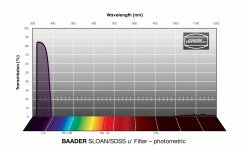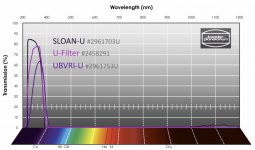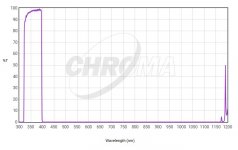Lars Harrekilde-Petersen
Member
Technical question:
As seen in the attached image, the rather new Baader U SLOAN/SDSS filter has some low level IR leak in the 1000 to 1200nm range.
Since I have a de-Bayer'ed (i.e. monochrome) CMOS camera, I wonder whether that leak may be troublesome.
I expect a typical full spectrum camera wouldn't have problems with it, since the CFA will cut there, but a bare silicon sensor may be too sensitive.
I am specifically hoping Klaus Schmitt will be of help here!
I also wonder whether the SLOAN/SDSS version may cut some important wavelengths near 390nm that the "usual" Baader U Venus (350nm) or particularly the UBVRI Bessel version include.
See the next attached graph (which Baader Planetarium was kind enough to provide me).
As seen in the attached image, the rather new Baader U SLOAN/SDSS filter has some low level IR leak in the 1000 to 1200nm range.
Since I have a de-Bayer'ed (i.e. monochrome) CMOS camera, I wonder whether that leak may be troublesome.
I expect a typical full spectrum camera wouldn't have problems with it, since the CFA will cut there, but a bare silicon sensor may be too sensitive.
I am specifically hoping Klaus Schmitt will be of help here!
I also wonder whether the SLOAN/SDSS version may cut some important wavelengths near 390nm that the "usual" Baader U Venus (350nm) or particularly the UBVRI Bessel version include.
See the next attached graph (which Baader Planetarium was kind enough to provide me).



